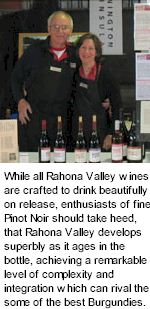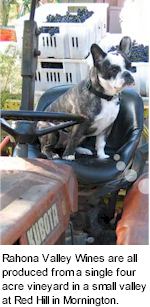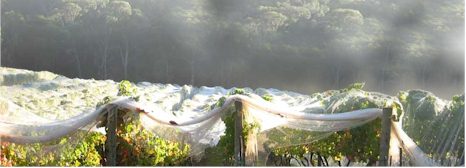


The estate's wines are all produced from a single four acre vineyard in a small valley at Red Hill on the Mornington Peninsula. The conditions are excellent, deep, well drained red basalt soils nurture the vines, as the cool maritime climes lead to a long, slow ripening period. Starting from scratch in 1991, the north facing 1.6 hectare vineyard surrounded by bushland now has 5000 hand tended vines of mostly Pinot Noir with a small block of Pinot Meunier. Here at Rahona Valley, the vines are mature and the drinkers are noticing the difference. All vines are own rooted, so provided there are a couple more generations of dedicated vignerons and winemakers, characteristics should compare with Burgundy. Rahona Valley's best wines are aged in the barrel for 18 months or more, whereas the normal process is to bottle after 12 months so that barrels can be reused for the next harvest.

Oak barrels impart a very important part of the flavour profile to wine and are also one of the most significant costs each year. The annual visit of the cooper to Rahona Valley is therefore one of those pivotal occasions that that will go a long way to setting the style of the vintage and it usually happens around 6 months before harvest. Selection of the timber is only the first step, next is the seasoning, two or three years? And where? Australia or France? Then there is the level of toast. This refers to the heat of the fires that are burned inside the barrel to make the staves bend, light medium or heavy. With so many variables, not to mention the fruit and the season it is very difficult to truly understand the impact of each different selection.
Pinot being a lighter style of wine is generally better suited to a tight grained timber so that the exchange of flavours is more subtle. Typically, oak from the Allier region of central France where a combination of lower rainfall and soil fertility slows growth giving that tighter grain. Within the Allier region the forest of Troncais seems to produce particularly good timber and is the most highly priced of all.
Cool climates can be both blessing and bane for viticulture. Even on the Mornington Peninsula there can be substantial losses. Commonly vineyards in frost prone areas have defensive measures such as windmills, helicopters, water sprays or frost pots cans filled with sump oil and other wastes that are burned to provide a smoke blanket that prevents heat loss by radiation. To affect a vine the shoots must be chilled to -2ºC or less. This is quite a severe frost, particularly to be that cold at cordon height, approximately 1 metre above the ground. If there is a lot of dew around the effect can be mitigated by the formation of ice crystals on the shoots which limits the cooling. This is why severe frost events are often associated with droughts because the atmosphere is too dry to form ice crystals.

In the cool climate areas of Australia and particularly at Rahona Valley, the components of the north facing site are expolited to allow maximum exposure to the sun, well-drained ancient basalt soil and an open canopy, to deliver beautiful disease free ripe fruit. Minimal wine making techniques and a restrained use of new oak allow this fruit to develop into an elegant wine with complex fruit flavours and well balanced tannin and acidity. As the Burgundians say, it's all in the fruit. The wine makes itself.
"You can tell straight away that these wines are all about the fruit. It literally sings with a story of where it came from. One minute I was in Mornington Peninsula, the next I was sipping Gevrey Chambartin in an underground cellar in the Cote de Nuits. They say great Pinot Noir is like an iron fist in a velvet glove, so strap on these mits. Such depth of fruit, lingering around in the mouth for eternity. Earth, savoury fruits, truffle, game meats and that’s just the nose. It is a wine that there is just not enough to go around. When you start talking barrels of a particular wine that tastes like a top Burgundy, grab it and don’t tell anyone else where you got it. Pinot Meunier adds weight and a fleshiness of fruit to Chardonnay and Pinot Noir in the blend for our favourite bubbly. As a stand alone wine, it is a real gem and with only 3 rows of vines contributing to the production, 1 to 2 barrels does not go a long way. Sweet dark brambly fruit with power and finesse to boot!" -Wine Satiety
Rahona Valley like to treat their wines to full malolactic, the conversion of relatively strong malic acid to relatively weak lactic acid by bacterial activity, softening the mouthfeel of wine. It occurs after the primary alcoholic fermentation. The factors that most influence ageing potential are grape type, acid/ tannin balance, vine age and length of time the wine is stored in the barrel. While all Rahona Valley wines are crafted to drink beautifully on release, enthusiasts of fine Pinot Noir should take heed, that Rahona Valley develops superbly as it ages in the bottle, achieving a remarkable level of complexity and integration which can rival the some of the best Burgundies.
